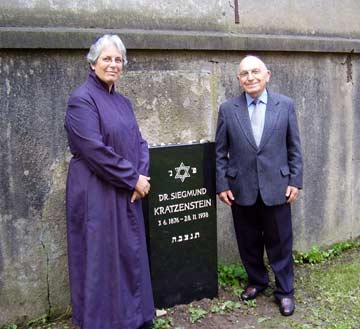| Deister-und-Weser-Zeitung Hamlin |
Return to News Archive March 7, 2014 |
No Trace of His Family

Harold Brown gives a living history lesson and rejects “Stolperstein” project.

By Wolfhard F. Truchseß,
Harold Brown gives a living history lesson and rejects “Stolperstein” project.
By Wolfhard F. Truchseß,
The only thing Harold Brown knows about his family is that his father immigrated to London from Poland in 1901. Harold himself has lived most of his life in Sydney, Australia. Harold Brown was speaking to the 11th grade of the HLA (Hamelin Business High School) in the sanctuary of the Reform Synagogue of Hamelin. “I never knew what our real name was. We were given the name Brown. I imagine our original Polish name was too difficult for the British officials to pronounce.” The 83-year-old Brown is married to the granddaughter of Dr. Siegmund Kratzenstein. Dr. Kratzenstein was a physician in Hamelin and the president of the Jewish community until 1938. He explained to the class, “I couldn’t find out anything about my own family’s fate during the Holocaust so I turned my interest toward my wife’s family and Hamelin.” He found the Web site of Bernhard Gelderblom and Rachel Dohme, the president of the Jewish Congregation of Hamelin. The relationship with Hamelin and the Jewish congregation was thus established.
This was not Harold Brown’s first visit to Hamelin. Several years ago he and his wife, Eva, were here and lent the Hamelin Museum valuable family heirlooms, among them his wife’s bridal gown. The dress was made from Belgian lace and mosquito netting that her mother had sewn after their escape from Nazi Germany and during their internment in a Japanese POW camp in Borneo. They survived because Eva’s father, like her grandfather, was a doctor and his skills were needed in the camp.
 Rabbi Irit Shiller and Harold Brown at the stone-setting ceremony in 2006 |
Harold Brown had an eventful Jewish life and shared his memories with the students. He recalled the Nazi bombing of London: “We were luckier than most. A bomb fell near our home, destroying the coal cellar, but no one was hurt. Thank God my father, my brothers and my cousins remained unhurt during the war.”
After the war ended, Harold worked in the London office of the Jewish Agency. There he worked with Abba Eban and Chaim Weizmann. He assisted young British Jews wanting to go to Israel. He told the young people a story about a friend he helped who had passage on a ship loaded with ammunition for the then underground organization Haganah. As the ship approached land the shooting started, and the young man saved himself by jumping into the sea and swimming ashore. “That was too dangerous for me.” Harold told the class he would not be emigrating.
In Australia Brown held various jobs—shoe salesman, taxi driver, salesman, real estate agent, and distributor and marketing manager for his own company, Digital Technologies Group. He told the class he would attend the Hannover Trade Fair to look for new and promising products.
Siegmund Kratzenstein’s granddaughter and her husband, Harold Brown, left a message with the city. They reject the so-called “Stolperstein” (stumbling stones) project and do not want a stone set into the sidewalk in front of Dr. Kratzenstein’s former home. He told the students the family has strong objections to this form of remembrance: “We do not want his name to be trodden upon again.”